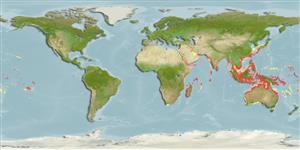Common names from other countries
>
Carangiformes (Jacks) >
Carangidae (Jacks and pompanos) > Caranginae
Etymology: Alepes: Greek, alepis, -idos = without scales (Ref. 45335).
Environment: milieu / climate zone / depth range / distribution range
Écologie
marin récifal; amphidrome (Ref. 51243). Subtropical; 46°N - 37°S, 19°E - 138°W
Indo-Pacific: Red Sea and East Africa (Ref. 12484) to the Hawaiian Islands, north to Japan, south to Australia. Immigrant to the eastern Mediterranean through the Suez Canal, wetward to Malta (Ref. 33971).
Length at first maturity / Taille / Poids / Âge
Maturity: Lm 16.3 range ? - ? cm
Max length : 40.0 cm TL mâle / non sexé; (Ref. 11228); common length : 25.0 cm FL mâle / non sexé; (Ref. 3397); poids max. publié: 603.00 g (Ref. 128705)
Épines dorsales (Total) : 9; Rayons mous dorsaux (Total) : 22 - 25; Épines anales: 3; Rayons mous anaux: 18 - 20.
Adults form large schools near inshore reefs (Ref. 30573). Feed on shrimps, copepods, decapod larvae and other crustacean larvae and small fish (Ref. 5213, 90102). Eggs are pelagic (Ref. 4233). Often caught by ski-boat anglers in southern Africa (Ref. 12484).
Bauchot, M.-L., 1987. Poissons osseux. p. 891-1421. In W. Fischer, M.L. Bauchot and M. Schneider (eds.) Fiches FAO d'identification pour les besoins de la pêche. (rev. 1). Méditerranée et mer Noire. Zone de pêche 37. Vol. II. Commission des Communautés Européennes and FAO, Rome. (Ref. 3397)
Statut dans la liste rouge de l'IUCN (Ref. 130435)
CITES (Ref. 128078)
Not Evaluated
Menace pour l'homme
Harmless
Utilisations par l'homme
Pêcheries: commercial; pêche sportive: oui
Outils
Articles particuliers
Télécharger en XML
Sources Internet
Estimates based on models
Preferred temperature (Ref.
115969): 24.7 - 29, mean 28 (based on 1150 cells).
Phylogenetic diversity index (Ref.
82804): PD
50 = 0.5312 [Uniqueness, from 0.5 = low to 2.0 = high].
Bayesian length-weight: a=0.01349 (0.01197 - 0.01520), b=2.95 (2.92 - 2.98), in cm Total Length, based on LWR estimates for this species (Ref.
93245).
Niveau trophique (Ref.
69278): 3.6 ±0.54 se; based on food items.
Résilience (Ref.
120179): Haut, temps minimum de doublement de population inférieur à 15 mois (K>0.3).
Fishing Vulnerability (Ref.
59153): Low vulnerability (18 of 100).
Climate Vulnerability (Ref.
125649): Moderate vulnerability (42 of 100).
